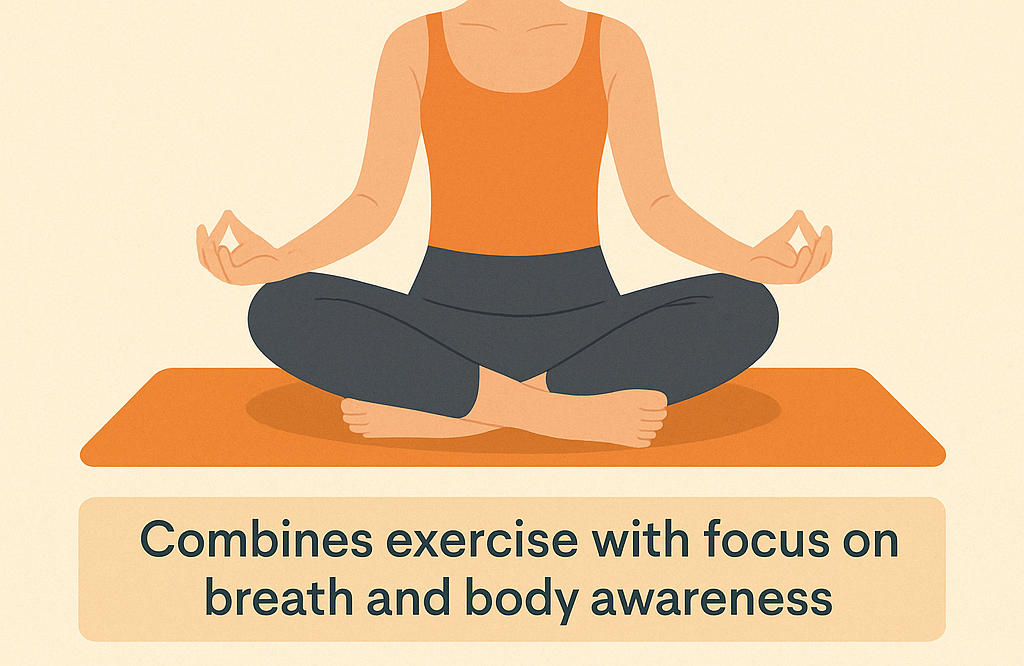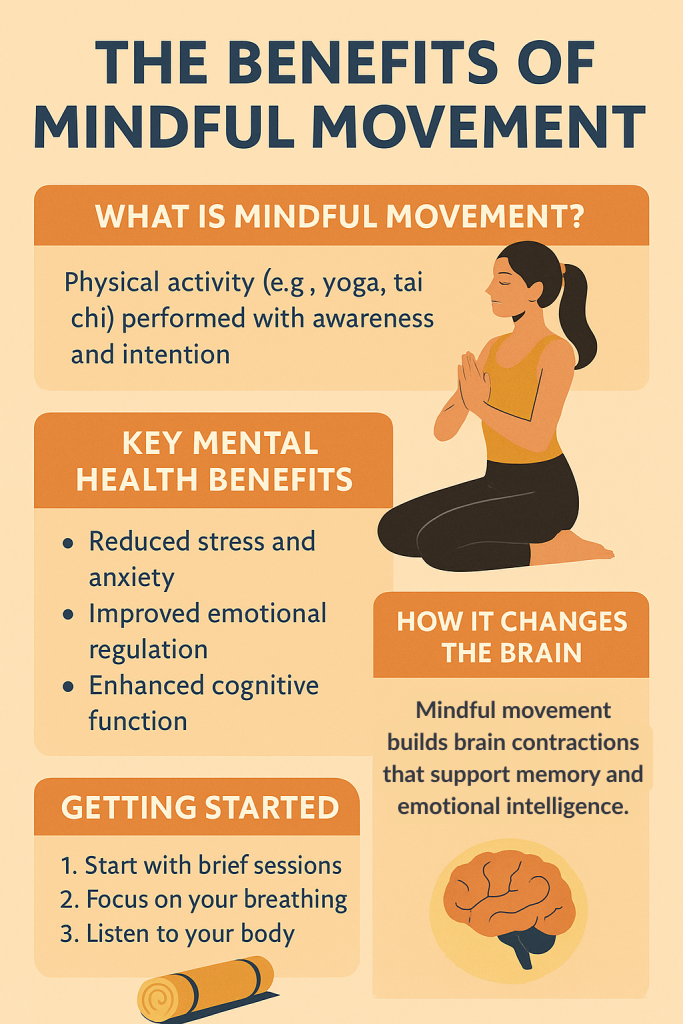The Science of Mindful Movement: How Yoga and Exercise Transform Mental Health
TL;DR: Mindful movement practices like yoga and tai chi can significantly improve mental health by reducing stress, increasing emotional regulation, boosting cognitive function, and fostering emotional healing. These practices activate the body’s relaxation response, calm the nervous system, and enhance self-awareness. Incorporating mindful movement into your routine helps reduce anxiety, build resilience, and promote lasting mental well-being, offering a holistic approach to managing modern mental health challenges.
Introduction: What Is Mindful Movement?
In our increasingly fast-paced world, the search for effective mental health solutions has led many to discover the transformative power of mindful movement. But what exactly is mindful movement, and how does it differ from your typical gym workout?
Mindful movement is a practice that combines physical activity with intentional awareness, breath control, and present-moment focus. Unlike traditional exercise that primarily targets physical fitness metrics like strength or endurance, mindful movement emphasizes the deep connection between mind and body. This approach includes practices such as yoga, tai chi, qigong, and even mindful walking—all designed to cultivate both physical wellness and mental clarity.
Related: Hydration and Mental Health
Is yoga a mindful movement? Absolutely. Yoga is perhaps the most well-known form of mindful movement, combining flowing postures with conscious breathing and meditation. Through mindful movement yoga, practitioners learn to synchronize their breath with movement, creating a moving meditation that calms the nervous system while strengthening the body.
The beauty of mindful movement lies in its dual purpose: while traditional exercise focuses on external goals like weight loss or muscle building, mindful movement nurtures internal awareness, emotional regulation, and mental resilience. This holistic approach makes it particularly powerful for addressing modern mental health challenges.
Recommended products
The Science Behind Mindful Movement and Mental Health
Recent neuroscientific research has revealed fascinating insights into how mindful movement literally rewires our brains for better mental health. When we engage in practices like yoga or tai chi, we activate the parasympathetic nervous system—our body’s natural “rest and digest” response that counteracts the chronic stress response plaguing so many of us today.
This activation leads to measurable physiological changes: cortisol levels drop, heart rate variability improves, and inflammatory markers decrease. The practice enhances interoception—our ability to perceive internal bodily signals—which is crucial for emotional regulation and self-awareness. This heightened body awareness, known as embodiment, helps us recognize stress signals early and respond more skillfully to emotional challenges.
Studies using advanced brain imaging technology have shown that regular mindful movement practice literally changes brain structure. As Harvard Health notes, “Yoga strengthens parts of the brain that play a key role in memory, attention, awareness, thought, and language. Think of it as weightlifting for the brain.”
Key Mental Health Benefits of Yoga and Mindful Exercise
Reduced Stress and Anxiety
One of the most scientifically documented benefits of mindful movement is its remarkable ability to reduce stress and anxiety. When we practice mindful movement exercises, we engage the body’s relaxation response, effectively switching off the chronic stress signals that contribute to anxiety disorders.
Research consistently shows that regular yoga practice significantly lowers cortisol levels—our primary stress hormone. A study published in the Journal of Clinical Medicine found that participants who practiced yoga for just eight weeks showed dramatic reductions in anxiety symptoms compared to control groups. The gentle, flowing movements combined with deep breathing create a natural anti-anxiety effect that rivals many pharmaceutical interventions.
Mindfulness through movement teaches us to observe our thoughts and sensations without judgment, breaking the cycle of anxious rumination that often perpetuates stress. This skill translates directly into daily life, helping practitioners approach challenges with greater calm and resilience.
Related: Anxiety: How To Stop Extreme Overthinking

Improved Emotional Regulation
Mindful movement practices excel at helping us develop better emotional regulation skills. Through consistent practice, we learn to calm the amygdala—the brain’s alarm center—while strengthening the prefrontal cortex, which governs rational decision-making and emotional control.
This neurological rebalancing helps practitioners respond to difficult emotions with greater wisdom rather than reacting impulsively. The practice teaches us to feel our emotions fully while maintaining perspective, a skill that proves invaluable in relationships, work situations, and personal challenges.
Regular mindful movement also increases emotional intelligence by enhancing our ability to recognize and name emotions as they arise. This emotional awareness becomes a powerful tool for maintaining mental equilibrium throughout life’s inevitable ups and downs.
Related: Overcoming Negative Thoughts
Enhanced Cognitive Function
The cognitive benefits of mindful movement extend far beyond stress relief. Research has shown that practices like yoga improve memory, attention span, and executive function while potentially counteracting age-related cognitive decline.
Brain imaging studies reveal that yoga practitioners have thicker cerebral cortex and hippocampus regions—areas crucial for learning and memory. This “brain training” effect occurs because mindful movement requires sustained attention, balance, and coordination, effectively providing a comprehensive cognitive workout.
Regular practitioners often report improved focus, clearer thinking, and enhanced problem-solving abilities. These cognitive improvements appear to be cumulative, with longer-term practitioners showing the most significant benefits.
Trauma Recovery and Emotional Healing
Emerging research in trauma therapy has identified mindful movement as a particularly effective tool for healing emotional wounds. Trauma often becomes “stored” in the body, manifesting as chronic tension, pain, or emotional numbness. Gentle movement practices help release these stored traumatic patterns while providing a safe space for emotional processing.
Trauma-sensitive yoga, specifically designed for trauma survivors, emphasizes choice, safety, and body awareness. This approach helps individuals reconnect with their bodies in a healing way, gradually rebuilding trust in their physical experience and emotional responses.

How Mindful Movement Changes the Brain
Advanced neuroimaging studies have provided remarkable insights into how mindful movement literally reshapes our brains. MRI scans of long-term yoga practitioners reveal increased brain connectivity and thickness in regions associated with memory, learning, and emotional regulation.
These neuroplastic changes aren’t just temporary—they represent lasting structural modifications that enhance cognitive function and emotional resilience. The practice appears to promote the growth of new neural connections while strengthening existing pathways related to attention, self-awareness, and stress management.
Perhaps most remarkably, these brain changes can occur relatively quickly. Some studies show measurable improvements in brain structure after just eight weeks of consistent practice, suggesting that the benefits of mindful movement are accessible to anyone willing to commit to regular practice.
Related: Integrated Behavioural Health
Practical Tips: Getting Started with Mindful Movement
Ready to experience the mental health benefits of mindful movement? Here are 10 mindful movements and strategies to begin your journey:
For Beginners:
- Mountain Pose with Breath Awareness – Stand tall, focus on your breathing for 2-3 minutes
- Gentle Cat-Cow Stretches – Move slowly, synchronizing breath with movement
- Mindful Walking – Take 5-minute walks focusing entirely on each step
- Seated Spinal Twists – Perfect for office breaks, emphasizing breath coordination
- Child’s Pose – A restorative position for stress relief and introspection
Building Your Practice: 6. Sun Salutations – Classic yoga flow combining multiple postures 7. Tree Pose – Balance posture that enhances focus and stability 8. Warrior Series – Strength-building poses that cultivate mental resilience 9. Bridge Pose – Heart-opening posture that energizes while calming 10. Corpse Pose – Deep relaxation technique for integration and restoration
Key Guidelines:
- Start with just 10-15 minutes daily rather than attempting lengthy sessions
- Prioritize consistency over intensity—regular short practices yield better results than sporadic long ones
- Use guided videos or apps initially to learn proper form and breathing techniques
- Listen to your body and modify movements as needed
- Consider joining a beginner-friendly class for personalized guidance
Recommended Resources:
- Yoga with Adriene (free YouTube channel)
- Headspace app for guided mindful movement sessions
- Local community centers often offer affordable beginner classes
- Books like “The Mindful Body” by Ellen Langer for deeper understanding
Start your mindful movement practice today with our Yoga Geometric Leggings – Purple One—perfect for yoga enthusiasts who want to combine comfort and style.

Conclusion: Embracing Mindful Movement for Lasting Well-being
The scientific evidence is clear: mindful movement practices like yoga, tai chi, and qigong offer profound benefits for mental health that extend far beyond temporary stress relief. These practices provide a comprehensive approach to wellness that addresses our modern mental health challenges at their root.
By reducing stress hormones, improving emotional regulation, enhancing cognitive function, and literally rewiring our brains for resilience, mindful movement offers a natural, accessible path to lasting mental wellness. The practice teaches us to inhabit our bodies with awareness, respond to challenges with wisdom, and cultivate the inner resources needed for thriving in our complex world.
Whether you’re dealing with anxiety, seeking better emotional balance, or simply wanting to enhance your cognitive function, incorporating mindful movement into your routine can provide transformative benefits. The key is to start where you are, be consistent, and trust in the process of gradual, sustainable change.
Your mental health journey doesn’t require dramatic changes—sometimes the most profound transformations begin with simply taking a conscious breath and moving your body with intention. The path to better mental health through mindful movement is available to you right now, one mindful moment at a time.
Recommended products
References to Key Research
- Harvard Health: “Yoga for better mental health” – Comprehensive review of yoga’s neurological benefits
- BlueCrest Health Group: “The Mental Health Benefits of Mindful Movement” – Clinical insights into movement therapy
- Mindfulness Association: “Benefits of Mindful Movement” – Research compilation on awareness-based practices
- Positive Psychology: “Mindful Yoga as a Therapeutic Tool” – Evidence-based therapeutic applications
- INTEGRIS Health: “The Benefits of Mindful Yoga” – Medical perspective on yoga’s health impacts
- PubMed Central: “The role of a mindful movement-based program” – Peer-reviewed clinical studies
Ready to transform your mental health through mindful movement? Start with just 10 minutes today and discover the powerful connection between conscious movement and emotional well-being. Share your journey with us and join a growing community committed to holistic wellness.









